Go Back to current column
NEW: Frank Van Riper Spring Classes…below
Nikon D300: The New Prosumer Champ
Fuji’s S5 may look like its twin, but the D300 wins going away
By Frank Van Riper
Photography Columnist
It has been a classic seesaw battle over the years between each new set of Nikon and Fuji “prosumer” DSLRs. These are the cameras that won’t put you in the poorhouse if you are an avid amateur shooter, yet come crammed with so many features that they would satisfy many if not all of today’s new generation of “f8 and be there” professionals.
This head-to-head (or camera body-to-camera body) competition began more than five years ago when Nikon unveiled its hot little D100 and Fuji touted its Finepix S2 Pro. The competition between these two cameras seemed a natural since both were built around the same Nikon body, with Fuji inserting its own digital insides. Each camera featured the legendary Nikon lens mount and each was geared to the same photo demographic. And so, as with the classic contests of decades past between the old Brooklyn Dodgers and the New York Yankees, a great rivalry was born--while Canon and other manufacturers did their own thing, catering to the lower and higher ends of the camera market.
In my own reviews, of the D100 vs. the S2, and three years later of the D200 vs. the S3, I gave the decision to Fuji—hands-down in favor of the S2 in the first review, and later by a much closer margin to the S3. Other reviewers seemed equally divided over which of these great prosumer cameras was better.
I was prepared to go through another agonizing set of personal, real-world tests when Nikon came out with its heavily-touted D300 and Fuji (with less fanfare) unveiled its top-of-the-line S5.
This time, however, I found it to be no contest. Though each camera looks like a twin of the other, and though each in its own way is a terrific machine, the Nikon D300 is—in my opinion anyway—a better value, a better performer, a better camera, than the Fuji S5.
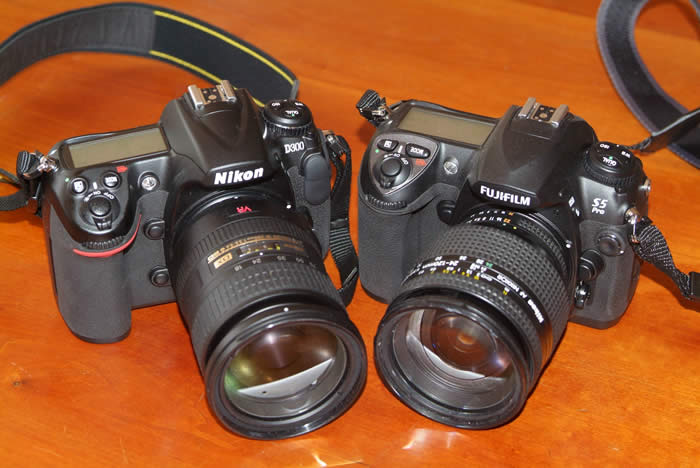
Nikon D300 (left) and the Fuji Finepix S5 Pro. They could be twins but underneath Nikon gives more bang for the buck. (c) Frank Van Riper
Once again, as it did when it unveiled its brilliant film camera, the F5—and later when it introduced its lower-priced but in some ways even more impressive F100—Nikon has leapfrogged the field not only to best the competition, but to trounce it.
Which is not to say the S5 is a bad camera. Far from it. Let’s be real here: if I were on a desert island with only an S5 to shoot, I’d be one very happy castaway. In fact, the S5’s remarkable sensor is in some ways better than that of the D300. Fuji has built a deserved reputation on the ability of the sensors on its pro-level DSLR’s to gather light, and the S5’s is no exception. In this column you will see unmanipulated examples of the same picture made with the D300 and the S5 (all made, by the way, with the same lens.) I think you will agree that the S5’s images are generally lighter and show more detail than those of the D300.
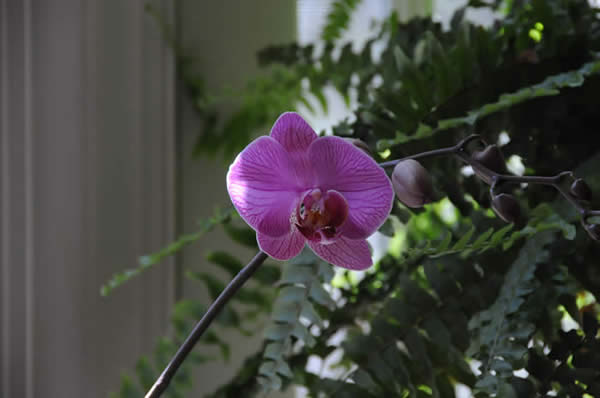
Available light flower closeup shows a distinctly brighter rendition in the S5 image (top) versus the D300 image below. Photos shot under identical conditions. (c)
Frank Van Riper
That in itself is a great testament to a great camera, and nothing here should be viewed as a knock against the S5’s quality. But that kind of sensitivity can, in fact, be a little too much of a good thing. On more than one occasion when I was shooting by available light in circumstances where I wanted to capture a specular, moody or directional quality of natural or artificial lighting, the S5 image was simply too light—sacrificing what I was looking to record—while the D300 more accurately reflected what I had set out to shoot.
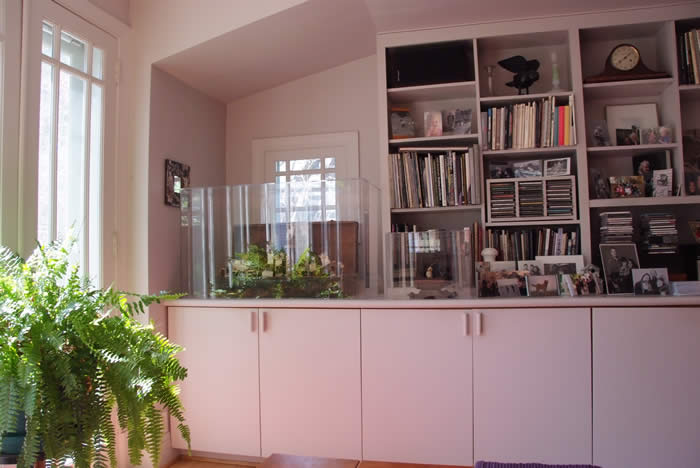 |
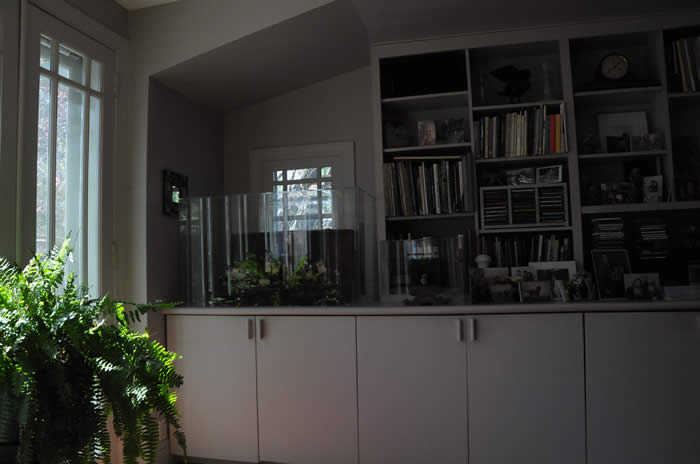 |
| Here it’s your call which to prefer. The top available light shot made with the S5 is lighter. The darker bottom image, made with the D300, more accurately depicts the scene. (c) Frank Van Riper |
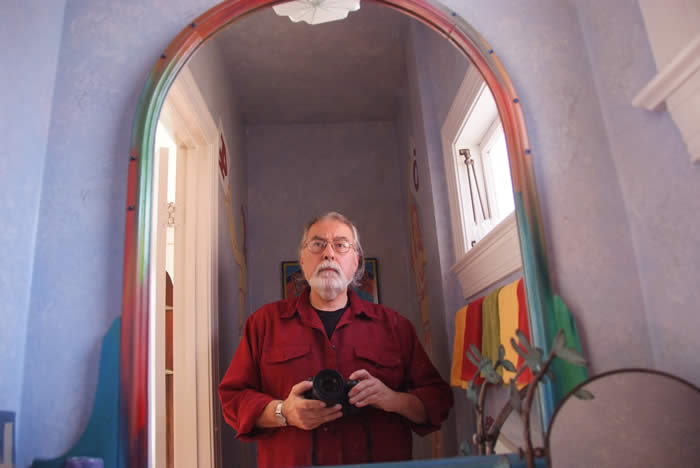 |
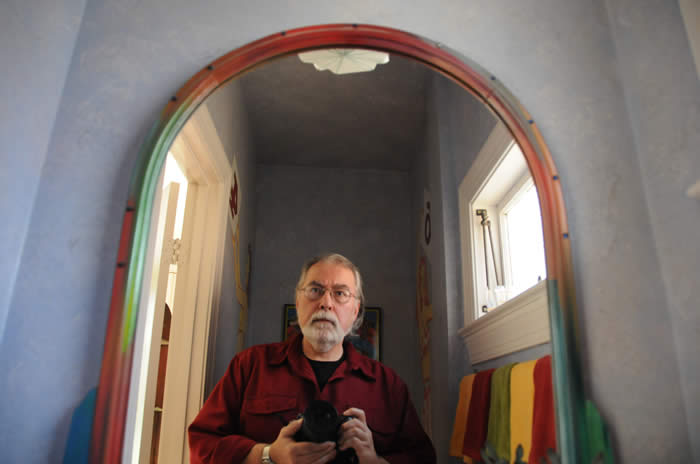 |
So too, there is a subtle difference in these two self-portraits. The top S5 portrait once again is lighter, but the bottom D300 image captures the shadows caused by the raking window light much more effectively. In fact the top image looks a little blown out. © Frank Van Riper
|
In truth, all other things being equal, I might have “put up” with the hyper-sensitive Fuji sensor and once again have come down in favor of the Fuji product.
But this time, all things are not equal and here is where Nikon has excelled.
It basically boiled down to this--with a nod to that great photographer William Shakespeare: It’s not that I loved the S5 less, but that I loved the D300 more—a lot more.
I can’t help shake a feeling that Fuji engineers were not really trying to top themselves when they developed the S5. Nikon, one senses, was looking to do just that, cramming so many little and not-so-little changes and improvements into its top-of-the-line prosumer camera that you literally can’t ignore it.
Take the damn viewing screen, just for starters.
Look at the difference between the D300 and the S5. The S5 gives you the same piddly sized screen that was on its predecessor S3, while Nikon gives you the functional equivalent of a wall-hung flat screen TV. No one to whom I have shown the D300 hasn’t ooh’d and aah’d over this humongous screen—and with good reason. So large is this display that even with some (very welcome) tech data at the bottom, the image is wonderfully easy to see. This is especially welcome to pros like me when working long events in dark rooms.
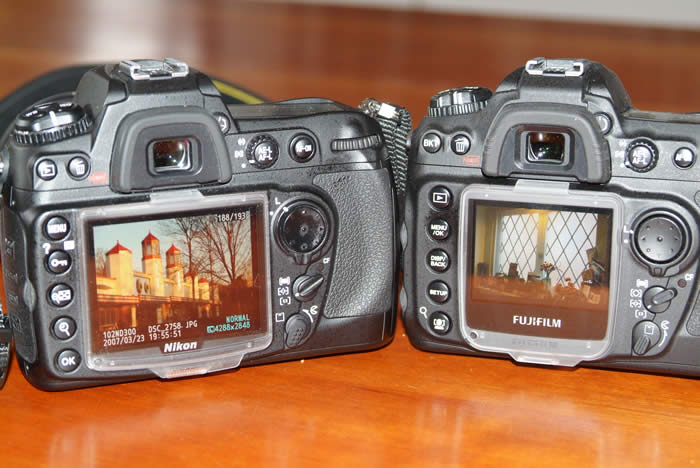 |
No contest in the viewing screen department. The D300 screen at left is far and away larger and therefore easier to read than that on the S5. In fact the S5 screen is the same as that found on its predecessor S3. © Frank Van Riper
|
Then there is the S5’s image processor.
Is this thing on vacation, sending postcards of images? It’s as if the S5 is mailing its images to me via the US Postal Service compared to the instantaneous feedback I get with the D300. I am not making this up: on the D300, the image you take shows up on that huge screen immediately. On the S5 it was literally “one banana, two ba…” before you saw anything. That’s roughly a one-and-a-half second lag for each exposure to show itself. In today’s real world of instant digital gratification, that simply is unacceptable, especially to a pro working under the gun covering breaking events or even something as mundane as a wedding with an impatient bride.
Other reviewers have commented on the steep learning curve that accompanies each camera. There is no doubt: cameras are getting harder, not easier, to use today in this glorious, wonderful, God-we-all-should-be-grateful age of digital. [I say this as a dyed-in-the-wool devotee of the film-loving and delightfully simple-to-use Leica M6.] Both the D300 and the S5 have manuals the size of novellas. Only the D300, though, seems to have lessened the pain of having to wade through its in-camera menus.
Make no mistake: there is a thicket to wander through in each, but almost as a consolation the D300 has included among its electronic gewgaws several very welcome and user-friendly features, including D-lighting and in-camera red-eye reduction. These little gems do in the camera what Photoshop does for a lot of us at the computer. D-lighting is like a mini “levels” control that can lighten a picture or punch up contrast with uncanny ease and accuracy. The flick-of-a-button red-eye correction also is a welcome way to limit the time one has to spend going glassy-eyed in post-production.
Added benefit: when using either of these features, the camera makes the fixes on an immediate clone of your image, leaving the original intact should you ever need it.
A few final thoughts:
--Neither of these first-rate cameras is cheap. When first unveiled, list price on the D300 body was roughly $1,800; on the S5 just under $2,000. In ensuing months the prices on these cameras have lowered significantly so check around for the best deal.
--Neither of these prosumer cameras has what some seem to think is the Holy Grail of digital imaging; the full sensor that replicates in digital the aspect ratio of 35mm.
Big deal. This argument always seemed made by people with too much time on their hands. It’s image quality, not size that counts. And with huge megapixel counts as well as first-rate image processing, both the D300 and S5 are winners.
--Finally, where the predecessor Fuji S3 helped beat out the predecessor D200 with its original equipment vertical shutter release, neither new camera has this feature—which I think is a shame. As a professional photographer who does a ton of commercial portraiture, I found the vertical release to be a godsend, freeing me from the repeated contortion of using the topside shutter button while turning the camera vertical.
With both the D300 and the S5, the vertical release can be had only with an optional supplemental battery pack. Each pack effectively doubles the shooting time of the camera by holding two, not one, proprietary rechargeable—or a passel of double-A’s, if so desired.
As options go, not a bad one.
So on balance, which camera should you buy? I chose the D300. Others might just as easily choose the S5. Given the fact that each is a terrific camera and that each is WAY less expensive than their top-of-the-line professional counterparts, there’s really no wrong decision here.
Frank Van Riper Classes and Field Trips, Spring, 2008
Glen Echo Park Photo Works
Master Class with Dr. Flash
Five-week hands-on studio class helps you master small flash units and studio strobes. Students will learn still life, tabletop and portraiture techniques in step-by-step demonstrations and individual exercises with professional flash gear. (Thursday evening April 3-May 1, 7-10:30pm, $350)
Field Trip, National Gallery East Wing, Sunday, 4/27/08
Endless opportunities for shooting - people, architecture, abstracts in beautiful light. Lunch and discussion at the gallery. A brief organizational meeting will be held prior to the trip at Photoworks and a follow-up potluck at Frank's house. For info, contact instructor at GVR@GVRphoto.com or 202-362-8103. (Sunday, April 27th, 10:30am-4pm; before and after sessions TBA; $150)
Basic Flash Workshop
Four week hands-on workshop will help students get the most out of their small flash units to mimic results obtained with much larger professional gear. This workshop concentrates on the basics, with surprising results. (Thursday evening, May 15-June 5, 7-10:30pm; $275)
Field Trip, National Building Museum, Sunday, 5/18/08
One of Washington's most unusual interiors - the Italian Renaissance building that houses the National Building Museum - and some of the tallest interior columns in the world. Tripods permitted. Briefing meeting appx. one week prior to trip followed by post-trip potluck at Frank's house. For info contact instructor at GVR@GVRphoto.com or 202-362-8103. (Sunday, May 18th , 10:30am-4pm; before and after sessions TBA; $150)
-0-0-0-
Contact registrar: www.glenechopark.org or GVR@GVRphoto.com
Frank Van Riper is a Washington-based photographer, journalist and author. He served for 20 years in the New York Daily News Washington Bureau as White House correspondent, national political correspondent and Washington bureau news editor, and was a 1979 Nieman Fellow at Harvard. Among others, he is the author of the biography Glenn: The Astronaut Who Would Be President, as well as the photography books Faces of the Eastern Shore and Down East Maine/ A World Apart. His book Talking Photography is a collection of his Washington Post and other photography writing over the past decade. Van Riper’s photography is in the permanent collections of the National Portrait Gallery and the National Museum of American Art in Washington, and the Portland Museum, Portland, Maine. He can be reached through his website www.GVRphoto.com
[Copyright Frank Van Riper. All Rights Reserved. Published 3/08]
|